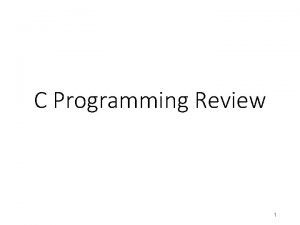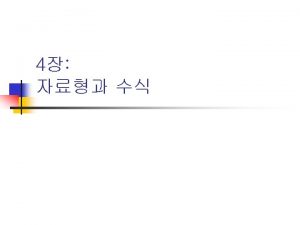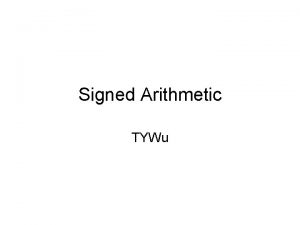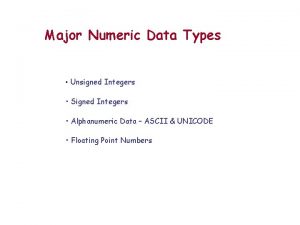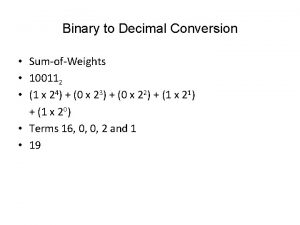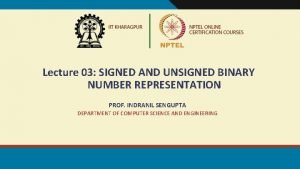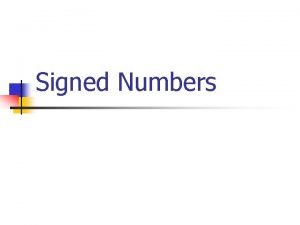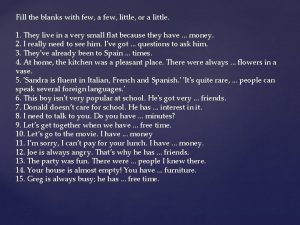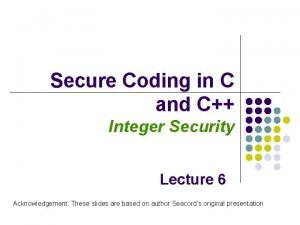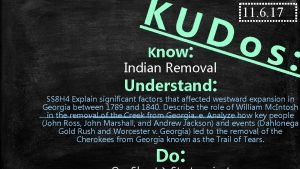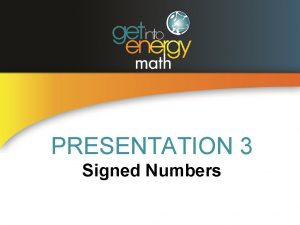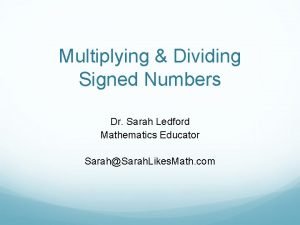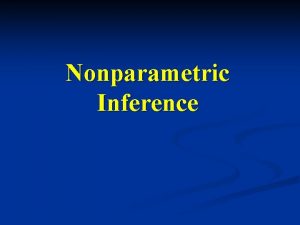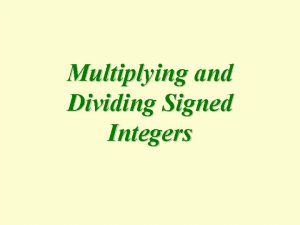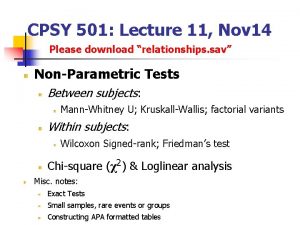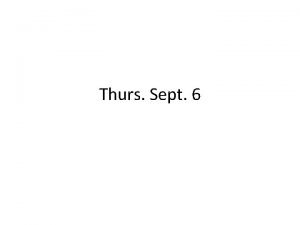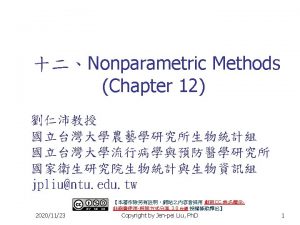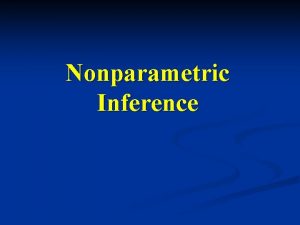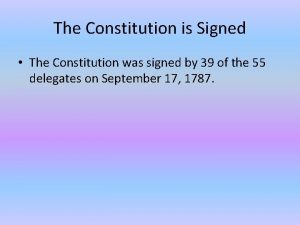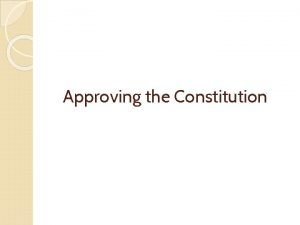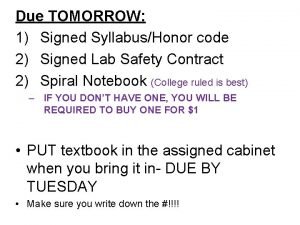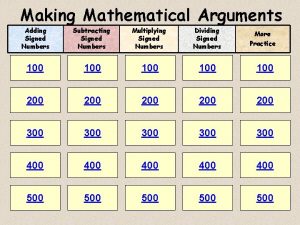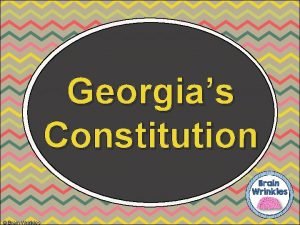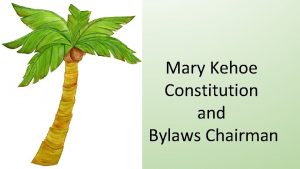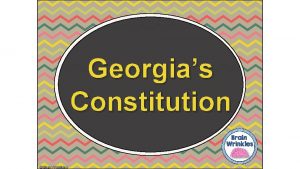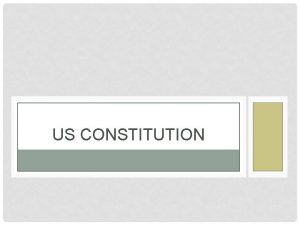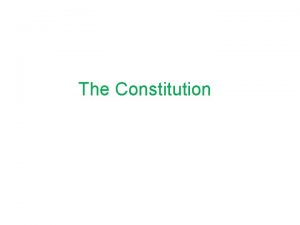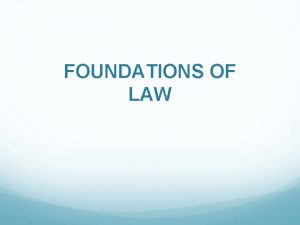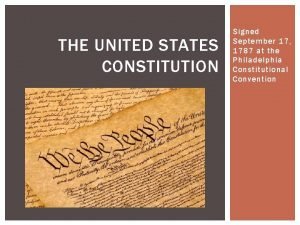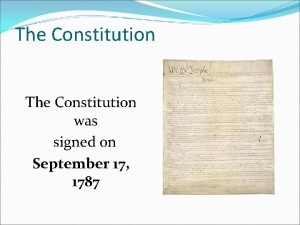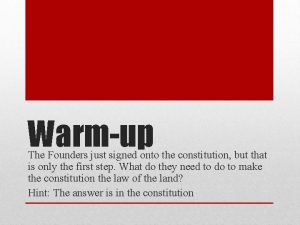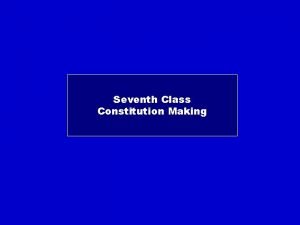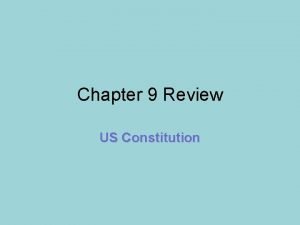The Constitution is Signed The Constitution was signed











































- Slides: 43

The Constitution is Signed • The Constitution was signed by 39 of the 55 delegates on September 17, 1787.

The United States Constitution • The Constitution of the United States of America is the written document that established a federal system of government based on power divided between the national and state governments.

Established the Basic Principles of our Government. • Separation of powers three separate branches of government: –Executive Branch (President) –Legislative Branch (Congress) –Judicial Branch (Supreme Court)

Executive Branch -The President Donald J. Trump

Executive Branch -The President Signs (approves) or Veto’s (does not approve) bills passed by congress - if signed the bill becomes a law - if vetoed the bill returns to Congress If two-thirds of all the members of Congress vote for the bill it can still become law. However, the bill dies when there are not enough votes to override the President.

Executive Branch -The President • Carries out federal laws • Recommends new laws to Congress • As Commander-in-Chief he directs national defense & commands the military • Directs foreign policy, and deals with international powers • Performs ceremonial duties.

Executive Branch Also includes: • Vice-President Mike Pence Secretary of State • The President’s Cabinet and others • Federal Departments • The State Department • The Department of Defense • The F. B. I. • And other Depts.


1. Who is the head of the Executive branch of government ?

2. If there are 100 senators, how many of their votes are required to override a veto?

3. Which would defiantly not be a part of the executive branch of the Federal Government? a. The Environmental Protection Agency b. The Federal Bureau of Investigation. c. The State Department d. The New York Department of Education

4. What is the name of the Vice President of the USA?

5. The President can do all of the things below except: a. Command the Military to evacuate American citizens from a foreign country b. Write a Law that prohibits the carrying of a loaded weapon. c. Sign a bill into law. d. Veto a bill and return it to Congress

Legislative Branch (Congress) • makes the laws.

Legislative Branch (Congress) • makes the laws. Congress is a two-house legislature. The Senate 100 Senators The House of Representatives 435 Congressmen

Legislative Branch (Congress) 1. The Senate - all states are represented equally in the Senate (two Senators per state) Senators serve for a 6 -year term NY Senators: Only the Senate can approve Charles or reject treaties and Schumer and Kirsten Gillibrand presidential nominations for government offices.

Legislative Branch (Congress) NY – 28 Congressmen and Congresswomen 2. House of Representatives (number of a state’s representatives is based on state’s population). Congressmen only serve a 2 -year term Only the House can introduce spending bills

Judicial Branch (Supreme Court) determines if laws made by Congress are constitutional. 9 judges (justices) serve on the Court; they are appointed for life.

Judicial Branch (Supreme Court) All of the other courts in the United States must follow the ruling or the decision made by the justices of the Supreme Court. the power to judge whether federal, state, and local governments are acting within the law. The Supreme Court can also decide if a president's action is unconstitutional.

Judicial Branch (Supreme Court) The wording of the Constitution is complex, so it must be studied and examined carefully. When questions concerning particular laws arise in lower courts, the justices who make up the Supreme Court are responsible for explaining and interpreting the Constitution.


1. What are the two houses of Congress called?

2. How many senators does each state have?

3. How many years does a senator serve?

4. What determines how many congressmen a state may send to the House of Representatives?

5. True or False: Only the Senate can approve or reject treaties made with foreign countries?

6. Name one senator from the state of New York.

7. Judicial Branch (Supreme Court) determines if laws made by Congress are ______.

8. How long a term does a Congressmen serve?

9. How long a term does a Justice of the Supreme Court serve?

10. The ________ Branch of our government makes the laws.

Aim: How does the U. S. Constitution's system of “Checks and Balances work? Do Now: Why do you think a government might need a system where one branch of the government has some control over what another branch does?

The Constitution established a government based on a system of Checks and Balances Each branch can check the power of the other. These checks keep any one branch from gaining too much power.

Examples of Checks and Balances If Congress passes a bill the President doesn't like… Executive Legislative

Examples of Checks and Balances …he can veto the bill… Executive Legislative

Examples of Checks and Balances But Congress can pass the bill into law over the veto by a vote of 2/3 of its members… Executive Legislative

Examples of Checks and Balances Congress also has the ability to impeach the President (remove him from office) if he commits "treason, bribery, or other high crimes and misdemeanors". Executive Legislative

Examples of Checks and Balances If Congress passes a law that The Supreme Court finds unconstitutional the law can no longer be used Judicial Legislative

Examples of Checks and Balances But Congress has the power to change the Constitution by passing amendments (changes) to it, although… Judicial Legislative

It is not easy to change the Constitution. Two-thirds of the House and Senate need to approve of the proposal and send it to the states for a vote. Then, three-fourths of the state legislatures must also affirm the proposed Amendment. Since 1787, over 9, 000 amendments have been proposed, but only 27 have been approved.

Examples of Checks and Balances The Supreme Court can decide that a president's action is unconstitutional Judicial Executive

Examples of Checks and Balances But it’s the President who selects candidates for the Supreme Court when one of the Justices retires or dies. Judicial Executive

Name one way in which: 1. The Executive branch of our government checks the power of the Legislative branch. 2. The Legislative checks the Executive 3. The Judicial checks the Legislative 4. The Legislative checks the Judicial 5. The Executive checks the Judicial 6. The Judicial checks the Executive
 The constitution lesson 1 principles of the constitution
The constitution lesson 1 principles of the constitution Texas constitution vs u.s. constitution venn diagram
Texas constitution vs u.s. constitution venn diagram Nc constitution vs us constitution
Nc constitution vs us constitution Constitution what is constitution
Constitution what is constitution Signed integer representation
Signed integer representation Signed and unsigned in c
Signed and unsigned in c Signed char
Signed char Verilog signed addition
Verilog signed addition Signed vs unsigned int
Signed vs unsigned int What is multiplicand and multiplier example
What is multiplicand and multiplier example Edge weight prediction in weighted signed networks
Edge weight prediction in weighted signed networks 11 from binary to decimal
11 from binary to decimal Signed and unsigned binary numbers
Signed and unsigned binary numbers Signing something you don t understand
Signing something you don t understand Section 3 of ra 10912
Section 3 of ra 10912 Signed number range
Signed number range I meet raisa last night and _____ signed _____ t-shirt. *
I meet raisa last night and _____ signed _____ t-shirt. * Signed and unsigned in c
Signed and unsigned in c Binary additon
Binary additon Plutonium
Plutonium Stevie wonder signed sealed delivered album
Stevie wonder signed sealed delivered album Flowchart for signed magnitude addition and subtraction
Flowchart for signed magnitude addition and subtraction Who signed the indian removal act of 1830
Who signed the indian removal act of 1830 Trail of tears
Trail of tears A message signed with blood to the nation of the cross
A message signed with blood to the nation of the cross Signed numbers examples
Signed numbers examples Multiplying and dividing rational numbers calculator
Multiplying and dividing rational numbers calculator Kruskal wallis test jmp
Kruskal wallis test jmp What year was the treaty of versailles signed
What year was the treaty of versailles signed Multiplying and dividing signed numbers
Multiplying and dividing signed numbers Signed statement for head covering
Signed statement for head covering Who signed the treaty of indian springs
Who signed the treaty of indian springs Spss wilcoxon signed rank test
Spss wilcoxon signed rank test Signed pleading
Signed pleading The violation of the sussex pledge
The violation of the sussex pledge Kruskal wallis test advantages and disadvantages
Kruskal wallis test advantages and disadvantages Unsigned signed
Unsigned signed H critical value table
H critical value table Balanced signed graph
Balanced signed graph Tia chieu sa te
Tia chieu sa te Các châu lục và đại dương trên thế giới
Các châu lục và đại dương trên thế giới Thế nào là hệ số cao nhất
Thế nào là hệ số cao nhất Chụp tư thế worms-breton
Chụp tư thế worms-breton Sơ đồ cơ thể người
Sơ đồ cơ thể người





